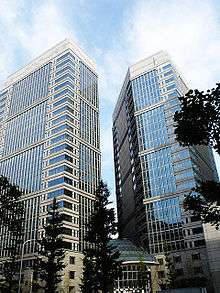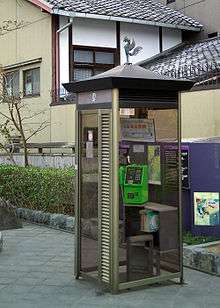Nippon Telegraph and Telephone
 | |
 NTT Headquarters | |
| Public KK | |
| Traded as |
TYO: 9432, NYSE: NTT, LSE: NPN |
| Industry | Telecommunications |
| Founded |
August 1, 1952 (as government monopoly) April 1, 1985 (Private Company) |
| Headquarters | Ōtemachi, Chiyoda, Tokyo, Japan |
Key people | Hiroo Unoura, President & CEO Satoshi Miura, Chairman |
| Products | Fixed-line and mobile telephony, broadband and fixed-line internet services, digital television, IT and network services |
| Revenue |
|
|
| |
|
| |
| Total assets |
|
| Total equity |
|
| Owner | Government of Japan (32.6%)[2] |
Number of employees | 241,593 (2015)[1] |
| Subsidiaries |
NTT Communications Dimension Data NTT Data NTT DoCoMo NTT i3 |
| Website |
www www |
The Nippon Telegraph and Telephone Corporation (日本電信電話株式会社 Nippon Denshin Denwa Kabushiki-gaisha), commonly known as NTT, is a Japanese telecommunications company headquartered in Tokyo, Japan. Ranked 65th in Fortune Global 500, NTT is the third largest telecommunications company in the world in terms of revenue.
The company is incorporated pursuant to the NTT Law (Law Concerning Nippon Telegraph and Telephone Corporation, Etc.).[3] The purpose of the company defined by the Law is to own all the shares issued by Nippon Telegraph and Telephone East Corporation (NTT East) and Nippon Telegraph and Telephone West Corporation (NTT West) and to ensure proper and stable provision of telecommunications services all over Japan including remote rural areas by these companies as well as to conduct research relating to the telecommunications technologies that will form the foundation for telecommunications.
While NTT is listed on Tokyo, Osaka, New York, and London stock exchanges, the Japanese government still owns roughly one-third of NTT's shares, regulated by the NTT Law.
History
Established as a monopoly government-owned corporation in 1952, Nippon Telegraph and Telephone Public Corporation (日本電信電話公社 Nippon Denshin Denwa Kōsha) was privatized in 1985 to encourage competition in the telecom market. In 1987, NTT made the largest stock offering to date, at US$36.8 billion.[4][5]
Because NTT owns most of the last mile (FTTC or FTTB/FTTH), it enjoys oligopolistic control over land lines in Japan. In order to weaken NTT, the company was divided into a holding company (NTT) and three telecom companies (NTT East, NTT West, and NTT Communications) in 1999. The NTT Law regulating NTT East and West requires them to serve only short distance communications and obligates them to maintain telephone service all over the country. They are also obligated to lease their unused optical fiber (dark fiber) to other carriers at regulated rates. NTT Communications is not regulated by the NTT Law.
In July 2010, NTT and South African IT company Dimension Data Holdings announced an agreement of a cash offer from NTT for Dimension Data's entire issued share capital, in £2.12bn ($3.24bn) deal.[6]
In late 2010, NTT's Japan-to-US transpacific network reached 400 Gbit/s. In August 2011, its network capacity was expanded to 500 Gbit/s.[7]
Corporate history timeline
- 1952 Nippon Telegraph and Telephone Public Corporation established
- 1979 INS Concept announced
- 1985 Nippon Telegraph and Telephone Corporation(NTT) incorporated as a private company
- 1987 NTT listed on the First Section of the Tokyo Stock Exchange
- 1988 NTT DATA Corporation started operations
- 1990 VI&P Concept announced
- 1992 NTT Mobile Communications Network, Inc.(presently NTT DOCOMO) started operations
- 1994 Basic Concept for the Coming Multimedia Age announced
- 1995 NTT DATA listed on the Second Section of the Tokyo Stock Exchange
- 1996 21st Century R&D Vision announced
- 1996 NTT DATA listed on the First Section of the Tokyo Stock Exchange
- 1997 Digitization of communications network in Japan completed
- 1998 Global Information Sharing Concept announced
- 1998 NTT DOCOMO listed on the First Section of the Tokyo Stock Exchange
- 1999 NTT's operations reorganized into a holding-company structure: businesses transferred to three new wholly owned subsidiaries (NTT East, NTT West, and NTT Communications)
- 2002 prefecture-based subsidiaries of NTT East and NTT West started operations
- 2002 "Vision for a New Optical Generation" announced
- 2004 NTT URBAN DEVELOPMENT CORPORATION listed on the First Section of the Tokyo Stock Exchange
- 2004 "NTT Group's Medium-Term Management Strategy" announced
- 2008 announcement of a new Medium-Term Management Strategy: "Road to Service Creation Business Group"
Subsidiaries
NTT Group consists of the following major companies, divided into five segments. NTT East, NTT West, NTT Communications, NTT DoCoMo, and NTT Data are most major subsidiaries. NTT DoCoMo and NTT Data are listed on the stock markets.
Regional

- NTT East (Tokyo)
- NTT West (Osaka)
Long distance & international
- NTT Communications
- NTT MSC
- Verio Inc
- NTT America
- On July 28, 2011, NTT America announced that it will use Bloom fuel cells at one of its data centers. It will power those Bloom fuel cells with biogas instead of natural gas to be more environmental-friendly.[8]
Mobile
Data (system integration)
- Dimension Data
- NTT Data
- NTT Comware
- NTT Software
- NTT IT
Information security
- NTT Com Security (formerly Integralis)[9]
- Solutionary
R&D laboratories [10]
- Service innovation Laboratory Group
- Service evolution Laboratories
- Media intelligence Laboratories (Yokosuka)
- Software innovation center (Yokosuka)
- Secure Platform Laboratories
- Information Network Laboratory Group
- Science and Core Technology Laboratory Group
- Network Innovation Laboratories (Yokosuka)
- Microsystem Integration Laboratories (Atsugi)
- Photonics Laboratories (Atsugi)
- Communication Science Laboratories (Keihanna)
- Basic Research Laboratories (Atsugi)
Sponsorship
- Omiya Ardija and Roasso Kumamoto (Japanese football clubs formerly affiliated with NTT)
- Hitotsuyama Team (Super GT teams affiliated with NTT Docomo)
- Tony Kanaan in the IndyCar Series
See also
References
- 1 2 3 4 5 6 "Financial Results Release for the Fiscal Year ended March 31, 2011" (PDF). Nippon Telegraph and Telephone Corporation. May 13, 2011. Retrieved July 29, 2011.
- ↑ "The Japanese National Property System and Current Conditions" (PDF). Ministry of Finance Japan. March 2013. Retrieved May 14, 2014.
- ↑ English translation of the "Law Concerning Nippon Telegraph and Telephone Corporation, Etc."
- ↑ Vartan, Vartanig G. (November 9, 1987). "Market Place; Big Stock Sale By Japanese". The New York Times.
- ↑ MSNBC.msn.com
- ↑ "NTT buys South Africa's Dimension Data". BBC News. July 14, 2010. Retrieved July 14, 2010.
- ↑ Sean Buckley, Fierce Telecom. "NTT's Japan to U.S. network route reaches 500 Gbps mark." Aug 3, 2011. Retrieved Aug 4, 2011.
- ↑ Katie Fehrenbacher, GigaOm. "Bloom Energy attracts data center operators in Cali." Jul 28, 2011. Retrieved Aug 4, 2011.
- ↑ "Integralis".
- ↑ http://www.ntt.co.jp//RD/OFIS/organization/lab_en.html
- Annual Report 2010, Nippon Telegraph and Telephone Corporation, March 31, 2010.
- Japan's Telecom Privatization Finished